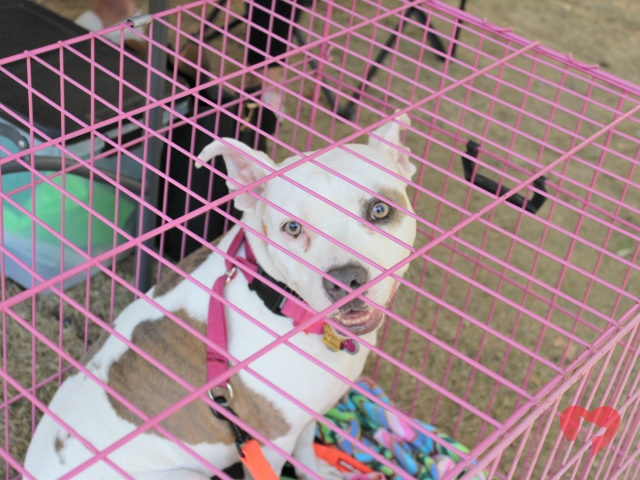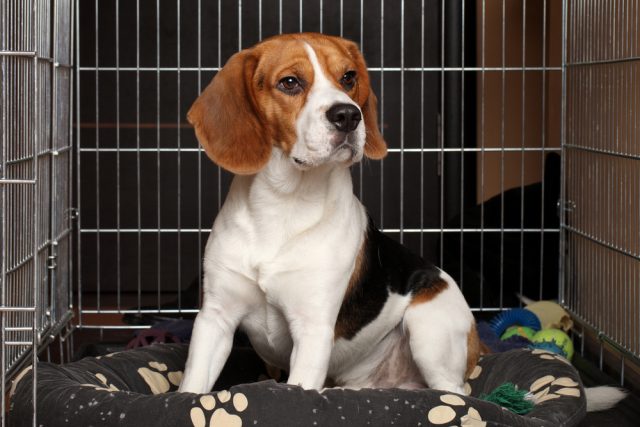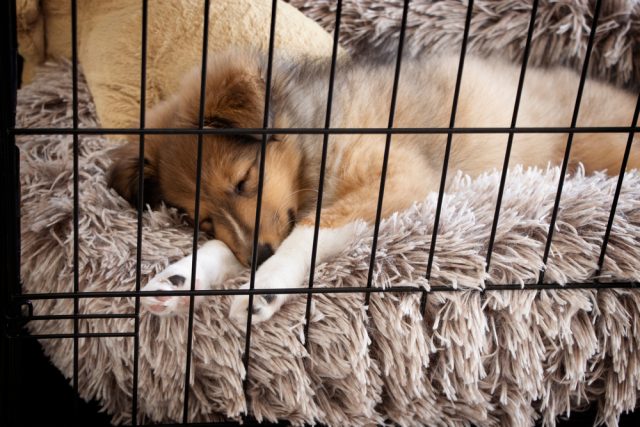Teaching your dog to love their crate should be a top priority for any new pet parent. Dogs are den animals, and enjoy small spaces where they can hide when they feel unsafe, or rest at nap time. It’s a safe space in your home that your dog considers his own. Crate training is easy to do and shouldn’t be something that makes you feel guilty or as if you’re subjecting your dog to “doggy jail.”
Understandably, some owners are firmly anti-crate, and that’s fine. You should never use the kennel as a “time out” space. And it is most definitely not a “cage” where your dog is confined for long periods of time. If your rescue dog’s past owner used the crate in a negative way, he may have an aversion to it. Perhaps a crate isn’t for him, but most dogs appreciate having their own space where they can relax.

Getting your dog to love their crate is going to take time. But with patience, your dog will see it as a home of their own.
1. Choosing The Right Crate
You might prefer a spacious room, but your dog only needs so much to love their crate. He should have enough room to lie down and stand comfortably. It should also be wide enough for him to turn around in a circle. Too much room gives your dog space to “go” in one spot and distance himself from it. You definitely don’t want to train him to use it as a bathroom.
If you’re crate training, you may want to choose a crate with a tray that slides out, because accidents happen. You can give a housebroken dog more space, but it’s not necessary. A comfortable “den” doesn’t require much room.
2. Location
You wouldn’t want to sleep on the floor in the kitchen no matter how comfortable it is, right? The crate is a place for rest, so pick a spot away from the hustle-and-bustle in your home. The laundry room might seem like a good idea, but noisy appliances can interrupt sleep or worse, trigger anxiety.
Consider sharing a bedroom with your dog. Not only will you provide a quiet, calm space for his crate, but he gets the added feeling of security of being close to his favorite person. It’ll give your dog another reason to love their crate!
3. Furnishing
No dog is going to love their crate when they feel cold plastic on their paws or worse, metal wire. Dogs prefer soft, firm spaces to rest. You may see your dog laying on your hardwood or kitchen tile, but it’s more likely for the coolness than the comfort. Providing a soft resting area can also help relieve pain in joints and keep elbow calluses from forming.
Some people provide a soft pillow or cushion, others will put a bed in. Eventually your dogs may carry in things on their own as they learn to love their crate. They’ll leave favorite toys and blankets in their “den.” Some dogs may even “bury” their treats in their bedding! You can help him love it more by putting some of his favorite things in for him. But don’t be surprised if they carry them right back out before they love their crate.
Training
Now that you know you have the right size crate and it’s cozy in a nice, quiet spot, it’s time to get your dog in.
4. Prime the Crate
Remember that the crate is a nice, calm place. So if your dog isn’t ready to get in, absolutely do not force him. Set a few treats inside. Let him walk past. Sniff. Be positive about any interaction he has with it. If you’re happy about it, your dog will love their crate in no time. If he only goes in far enough to reach the treats, start putting them back further so he has to go in a bit more. Eventually, he should become comfortable putting all four paws inside.
When he does go all the way in, reward him – use treats, praise, or both.
5. Feeding In The Crate
Now that the crate is a happy place he feels comfortable in, begin feeding your dog there. While he’s eating, close the door and latch it. After he’s done eating, leave the door closed for just a few seconds before opening it – but never open it while your dog is whining. The idea is to help your dog love their crate, not teach him that whining opens the door.
After meals, or any time you see your dog in his crate and you’re able to close the door, leave it closed for a bit longer, adding a few seconds until you work up to a minute. Gradually begin putting some distance between yourself and the crate while he’s there. If walking away makes your dog upset, placing a toy he loves in before shutting the door may help distract him.
6. Work Up To Longer Intervals
The goal is to be able to leave the room for ten to fifteen minutes at a time without your dog going nuts. Teaching a “crate” or “kennel” cue will help get him in a few times a day to practice staying in several minutes at a time, until you can leave him calmly in his crate for 30 minutes. When he reaches the 30 minute mark without you in the room, you can feel confident leaving him is his kennel while you leave the house for a short period of time.
The process takes time, but it’s absolutely worth it. A crate may be convenient for you, but you’re really giving your dog a room of his own where he can go when stressed or scared. When used and introduced correctly, your dog will love their crate and consider it a haven.
Dos and Don’ts
NEVER use your dog’s crate as a punishment and do not keep him there for long periods of time. Your dog will not love their crate if you make them spend all their time there. Dogs were not meant to live in cages.
Provide water and entertainment, like toys, television or radio while you’re out. We do not recommend giving your dog chews or any toys he would put into his mouth while left unattended. Try a puzzle toy instead. He’ll earn treats throughout the day as he figures it out! Teach him how to work the puzzle while you’re home so he enjoys it more on his own.
Be sure to start with small periods of time – a dog who does not want to be in their crate can injure themselves trying to get out of it. Working up the amount of time will keep them from causing themselves harm and help them love their crate gradually.
Remember that young puppies and older dogs will need to “go” more often than adult dogs. A dog should not be asked to “hold it” for longer than an hour for each month they are old, and past that, no dog should wait longer than 8 hours to pee. If possible, do not crate your dog if you know you’ll be out of the house longer than 5 hours. Consider a dog sitter or daycare.


 Toledo, United States.
Toledo, United States.